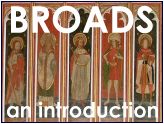
home I index I introductions I e-mail I about this site

9. About the Broads I
Churches of the Norfolk Broads I
Every summer, hundreds of thousands of holidaymakers descend on Broadland, that area of Norfolk between Norwich and Yarmouth intersected by the wide, lazy stretches of open water that have resulted from ancient peat-cutting. Many spend a fortnight afloat, weaving their hefty boats through the traffic jams. Others prefer the land - sometimes the sight of the water is preferable to the challenge of navigating it. Still others come for the day, drawn by pretty villages like Ranworth and South Walsham, or the chance of a pleasure boat trip, or even, incomprehensibly, the attraction of shopping in hellish Wroxham. On a beautiful day towards the end of July 2004 I went with Tom on a tour of 19 Broadland churches. There are twice as many as this; we had divided the area into two sections, and our journey would take us around one part, roughly those churches north of the River Yare. The sky stayed fair all day, and throughout the entire circuit we would find only two churches inaccessible, and one of those not unreasonably so. I've already written about Barton Turf, Catfield, Irstead, Ludham, Ranworth and Upton in the section on Amazing Screens, and about Bastwick, Billockby and Panxworth in Lost in Translation, so if you are interested in any of those nine you might want to go there instead. These are the other ten. Acle was a surprise in an otherwise dull town, for the survivals here are remarkable, not least one of Norfolk's most interesting fonts; but the graffito remaining from the Black Death is very moving, and the church also has Norfolk's only surviving brass for a 17th century minister. On the way to South Walsham we popped in on Fishley, marooned on a grassy island in the wide harvest fields. We found it locked, which was understandable, but without a keyholder, which was a pity. At South Walsham, the two churches of St Lawrence and St Mary are in the one graveyard. Both are welcoming, as are so many of the Broadland churches. St Lawrence is redundant; in fact, it was a ruin for nearly two centuries, but has been pressed back into service as a very fine parish hall. The restoration is excellent. St Mary is big, homely and unremarkable, but it has the best modern glass we saw all day. Beyond Ludham and Catfield, Sutton is a pleasant village full of ordinary houses; if the church is also ordinary then at least it is friendly, welcoming and very well-kept. The Tudor porch entrance and transitional font are very pleasing. Not far off is Ingham, which nobody could accuse of being ordinary, for this massive pile houses two huge memorials, both with life-size figures. Stalham is the urban setting for a church of uncommon interest, with one of Norfolk's most beautiful fonts and unusual screen panels. Unfortunately, our visit to this church was spoilt by an unpleasant incident. But after Barton Turf and Irstead we were pleased and surprised by Neatishead and Hoveton, before our descent into the mundanity of Wroxham where, at 6pm, the church was already locked. Still, it is the great Norman south entrance that is most worth seeing, and they can't shut that away. Click on the images below to read about each church. This is a prosperous area of Norfolk compared to some, but even so it was nice to see how well-kept and well-used most of the churches were. They felt like the living, breathing hearts of faith communities. Nearly all were welcoming; this part of the Diocese obviously takes its mission seriously. It was reassuring to feel that most of these buildngs are in safe hands for now. Simon Knott, September 2004 click below
to visit the churches Acle Fishley Hoveton Ingham Neatishead
Amazon commission helps cover the running costs of this site.
home I index I latest I introductions I e-mail I about this site I glossary |